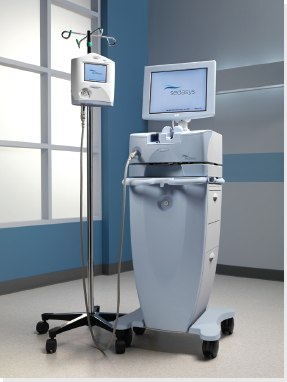To What Extent Will Medical Devices Replace Doctors?
October 12, 2015
From automated anesthesia systems to apps that promise to detect skin cancer, the use of artificial intelligence for clinical applications is steadily growing by the day, leaving observers to wonder what the role of clinicians will be in the years to come.
Kristopher Sturgis
|
A handful of hospitals are using Johnson & Johnson's Sedasys system, a computer-assisted sedation system. |
Are you ready for a robot anesthesiologist? A growing number of hospitals apparently are after FDA gave approval to the Sedasys automated anesthesia system, which enables doctors (with custom training) to administer the drug propofol during colonoscopy and esophagogastroduodenoscopy procedures. While only a handful of hospitals are now using the anesthesiology machines, the system appears to offer significant potential cost savings. While the use of a human anesthesiologist in a colonoscopy procedure can result in up to $2000 in additional costs per procedure, the use of the Sedasys system only costs $150 to $200. More advanced systems could mean that automated anesthesiology procedures are used for a growing number of procedures requiring sedation.
But the notion of algorithms or technologies replacing doctors outright still seems far fetched at the moment. But robotic systems could theoretically do just that in years to come--or they could at least take on a growing number of duties currently performed by clinicians. That in itself is not bad news considering that much of the world is facing a physician shortage.
Robots could, for instance, help do everything from care for the elderly to operate on patients. While there is no fully automated robotic surgical technology available, researchers from the University of California, Berkeley and the Center for Robotic Surgery in Singapore, announced last year that they had created technology that would enable the automation of surgery on soft tissue. For now, the focus is on having robots perform simple and repetitive surgical tasks, enabling human surgeons to focus on more-challenging and complex surgical operations.
In addition, recent developments at Vanderbilt University have equipped robotic arms with steerable wrists, enabling more surgeons to perform difficult surgeries that previously could only be performed by a handful of doctors around the world.
Even Google is getting into the game by partnering with Johnson & Johnson to kickoff a project designed to advance surgical robotic technology and by sponsoring research in surgical robotics.
The notion of surgical robotics expanding the capabilities of human surgeons is thematically similar to how IBM envisions its Watson artificial intelligence algorithm in healthcare--extending the capabilities of human physicians, whether in the ER or the radiology suite. Watson can read tens of thousands of pages of medical journal articles per week and can offer custom probability calculations for diagnosing patients.
Outside the operating room AI technologies could soon be doing tasks traditionally done by humans. A new technology made by Aethon known as Tug is a compact robot capable of transporting and delivering meals, medication, linens, and even lab specimens. The robot was built with navigation, basic communication capabilities, and an onboard map to help navigate hospital hallways and rooms.
Finally, as if advanced robotics and AI systems aren't enough, there's also your standard smartphone. With advanced computing capabilities, machine learning, and cloud technology, smartphones have become a ubiquitous tool in the healthcare industry. From smartphone-enabled devices that can diagnose, to various health tracking apps that can gather and analyze all kinds of data, smartphones are carving out more space by the day. Already the app SkinVision promises to help detect melanoma using a smartphone's camera and an algorithm.
While it should be noted that most of these technologies are still in the infancy stages of development, they do represent what appears to be a growing trend in the industry. AI technologies are growing in numbers, and it appears that technology will greatly change healthcare dynamics within the next decade.
Learn about cutting-edge medtech developments at MEDevice San Diego, September 1-2, 2015. |
Like what you're reading? Subscribe to our daily e-newsletter.
About the Author(s)
You May Also Like



